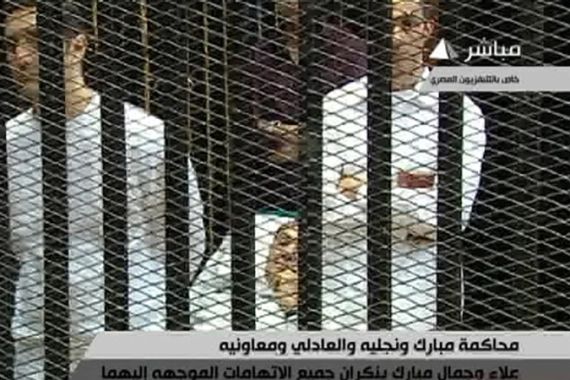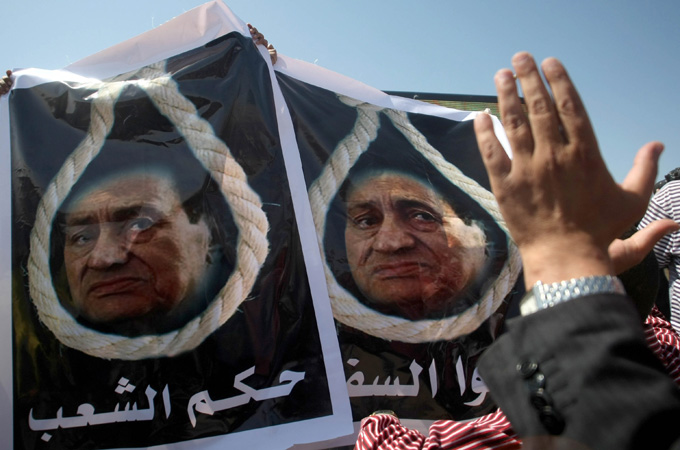Mubarak’s chaotic day in court
Lawyers crowded the bar with demands and theatrics as Mubarak lay prostrate, but the case against him is deadly serious.

 |
| Some demonstrators that gathered outside the court demanded the death penalty for the ousted president [AFP] |
It was a moment many in Egypt and elsewhere in the world never thought would happen: Hosni Mubarak, ruler of the Arab world’s most populous country for 30 years, in a cage.
Not only was the ousted leader behind bars, he was wheeled into the Cairo Police Academy on a hospital bed, dressed in white, his sons – co-defendants alongside him – leaning down to mutter questions from the judge.
Outside, a few hundred demonstrators gathered, some in support of the humbled leader, some to make sure the memories of those he is accused of conspiring to kill are not forgotten.
At times, the crowd, gathered before a large video screen displaying the proceedings, erupted into fights. Rocks and fists were thrown, belts pulled off as weapons, dozens injured and around 15 arrested.
But the real drama was inside the courtroom, constructed hastily over the past few days inside the academy that bore Mubarak’s name until the 18-day uprising forced him out of power.
The opening proceedings of the trial featured grandstanding, theatrical accusations and even moments of humor, but as prosecutor Moustafa Soliman read the charges, which carry the death penalty, it was clear the hearing was deadly serious.
The security forces that Mubarak’s regime made judge, jury and executioner over his decades of rule left hundreds of ordinary Egyptians dead and thousands wounded during protests that swept the country.
Now the country is prepared to mete out an equal punishment on Mubarak and his associates.
‘Bevy of complaints’
| In video |
|
Key players in courthouse for Mubarak trial |
Judge Ahmed Rifaat, the head of the Cairo Appeals Court who is presiding over the trial, spent much of the first day enduring a bevy of complaints, arguments and legal motions from dozens of lawyers on both sides of the case.
Lawyers representing ex-Interior Minister Habib el-Adly and six of his former top officers, who are all accused of conspiring to kill protesters, argued that it was illegal to join their case with the Mubaraks’ in the first place.
Previously, the Adly case had been proceeding alone.
They argued that Rifaat and his two fellow judges should visit a host of crime scenes around Tahrir Square, including the Ramses Hilton Hotel, Interior Ministry, and American University in Cairo, to see for themselves the places security forces are alleged to have fired on peaceful protesters.
They also asked to subpoena more than 10 military officers, ranging from colonels to generals, perhaps indicating what will be one of the defence team’s primary strategies: to focus blame for the regime’s murderous aggression and failure to prevent violence on the armed forces, which took to Egypt’s streets on the night of January 28, the revolution’s bloodiest day, and have held most of the power in the country ever since.
As the defence lawyer’s arguments continued, emotions among those representing slain or injured protesters rose. On two occasions, plaintiffs’ lawyers seized the microphone and complained that their voices should be heard and that they were outnumbered by defence attorneys.
After it seemed that most of the defence attorneys had been heard, Rifaat adjourned for a half-hour break.
Courtroom chaos
When the case resumed, the Mubaraks took centre stage. Soliman, the government prosecutor, read the official charges against the ex-president and his sons, Gamal and Alaa.
Mubarak is accused of conspiring in the premeditated and attempted murder of unarmed protesters, abusing his power to amass wealth, and allowing illegal below-market gas sales to Israel.
His sons are charged with using their influence and that of their father to illegally obtain five villas, worth a collective $5 million, in the resort town of Sharm el-Sheiklh.
The illegal sale was allegedly made by Hussein Salem, a businessman closely tied to the regime who fled to Spain and is being tried in absentia in the same case.
The court had fallen silent during the reading of the charges, but soon afterward a parade of plaintiffs’ lawyers appeared at the bar, each stating the number of killed or injured protesters they represented: 32, 50, one. Each made claims for recompense for those who had died; one of the highest was for 50,000 pounds, or roughly $8,600.
It was often hard to tell whether Mubarak was listening. At times he rested his head on his hands, looking like a man on vacation; at others, he wrapped one arm across his forehead, seemingly in pain.
Once, state television cameras caught him picking his nose, an image that did not go unnoticed by activists and was relayed again and again online.
Outside the cage, the scene in front of the bar reached a fever pitch, as dozens of lawyers struggled to have their case heard.
One man who took the microphone claimed that Mubarak had actually died in 2004 and that the man in the cage was an impersonator, placed there as part of an “American, Zionist” plot. Mubarak did not appear to react.
Another lawyer claimed that Mubarak and his sons had never officially had a criminal case opened against them and demanded they be fingerprinted. He pulled out an ink pad, opened it, and placed it before him. Rifaat ignored the demand.
Others made more substantive arguments. They asked the court to subpoena a long list of regime officials and corporate representatives.
Some wanted former prime ministers and high-ranking MPs to appear, others wanted to hear from Vodaphone, Etisalat and Mobinil – internet and mobile phone providers whose services were cut off, some allege with the companies’ easy acquiescence, after the uprising began on January 25.
Finally, Rifaat ordered all the lawyers to sit. Peering over his glasses like a schoolteacher, he repeated his order until the courtroom quieted.
Tantawi to appear?
Farid el-Deeb, the Mubaraks’ lawyer, took the bar. Every time he had spoken throughout the day, the room had listened, and this last time was no exception. He mentioned issuing a subpoena to bring Mubarak’s personal physician, a German, to appear.
But then he made the day’s biggest announcement: demanding the appearance of Field Marshal Hussein Tantawi, Mubarak’s defence minister and the current chairman of the military council that runs Egypt’s post-revolution affairs.
Tantawi, he argued, had ultimate authority over security affairs after soldiers took the streets on January 28. Rifaat took the demand in hand, adjourned, and then returned to make a short statement. Mubarak would remain in Cairo under the care of his medical team and the head of oncology at Cairo University.
The case against him and his sons will resume on August 15, while Adly and his aides will return Thursday. Mubarak was wheeled out.
The chaotic day gave little indication of where proceedings will go from here, but Deeb’s request did offer at least one tantalizing clue about the defence strategy. It appears Mubarak’s team and perhaps those lawyers representing Adly and his aides may argue that the military bears responsibility for the violence against protesters.
The Supreme Council of the Armed Forces (SCAF), which has managed Egypt since the uprising, is now in a difficult position. Should Tantawi refuse to appear, it may anger protesters who demand a fair and transparent trial. But if he shows, he may face tough questions from defence lawyers, potentialy revealing misdeeds by SCAF and endangering it’s hold on Egypt.
Though the path the trial will take and who it may ensnare remain uncertain, one thing was clear on Wednesday: Mubarak was no longer in control.
Follow Evan Hill on Twitter: @evanchill